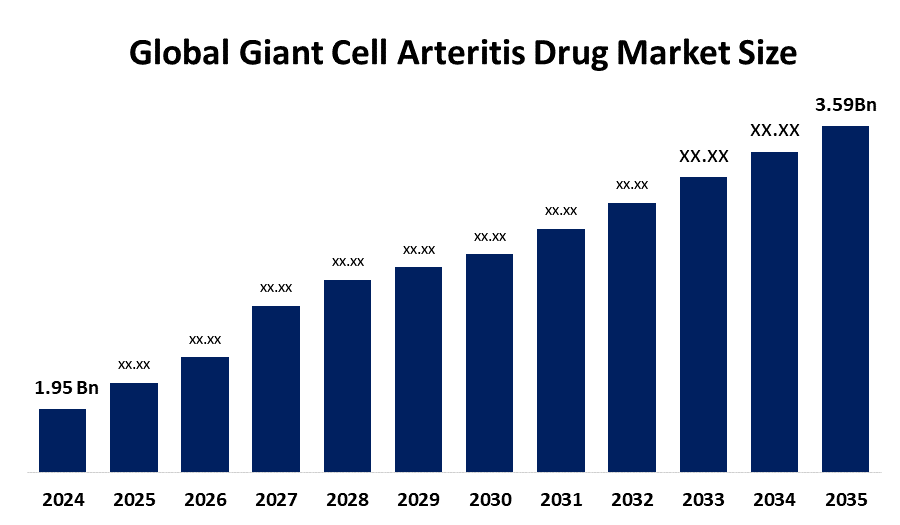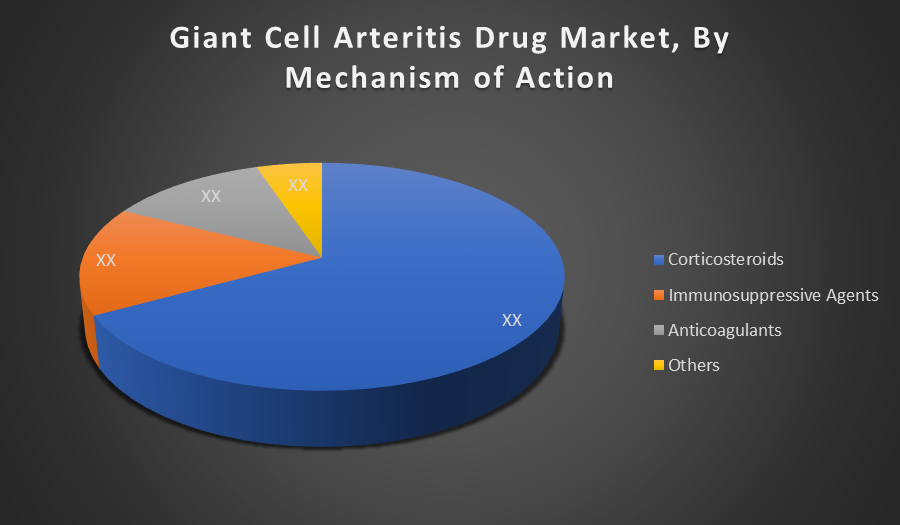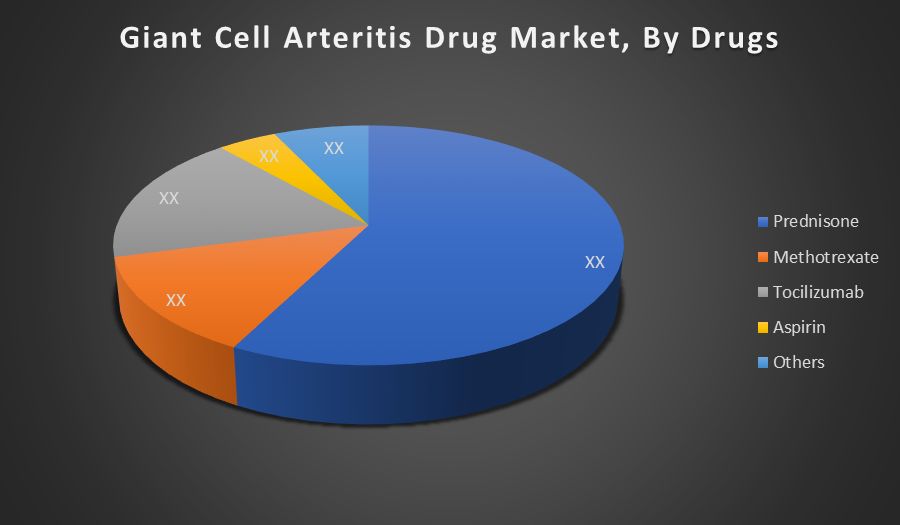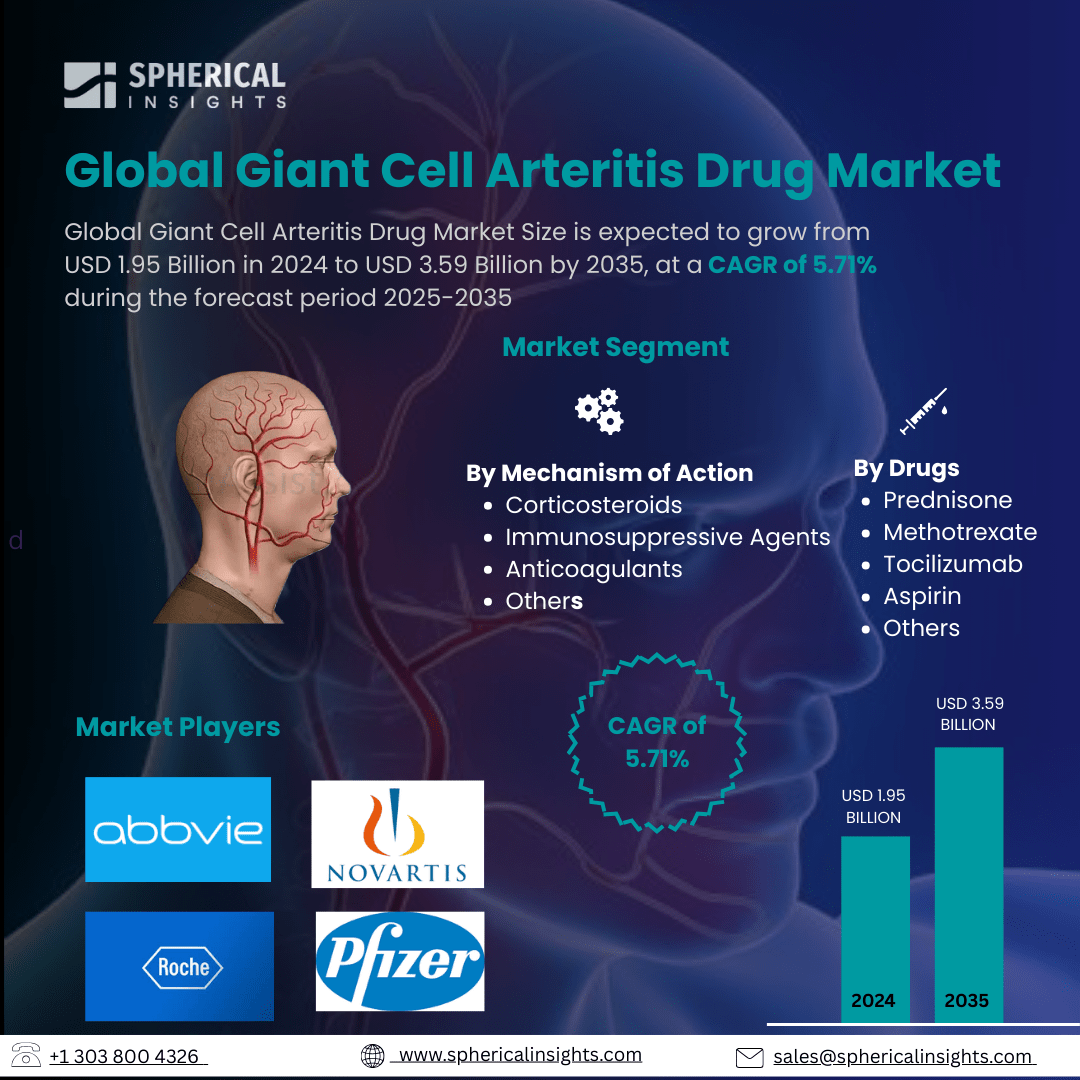- As per Spherical Insights & Consulting, The Global Giant Cell Arteritis Drug Market Size is expected to grow from USD 1.95 Billion in 2024 to USD 3.59 Billion by 2035, at a CAGR of 5.71% during the forecast period 2025-2035, owing to the launch of new therapies in the market and the rise in the number of cases.
- The leading Giant Cell Arteritis Drug Market Companies such as AbbVie, Novartis, Roche, Pfizer, GlaxoSmithKline, Amgen, Sanofi, Eli Lilly, Bristol-Myers Squibb, Janssen Pharmaceuticals, UCB Pharma, Sandoz, Horizon Therapeutics, Regeneron Pharmaceuticals, Mitsubishi Tanabe Pharma, and Others.

Giant Cell Arteritis Treatment Market: Understanding and Treatment Algorithm:
Giant cell arteritis is an inflammatory disease affecting large and medium-sized arteries, especially in the head. It causes symptoms like headaches, scalp tenderness, and vision problems. If untreated, it can lead to serious complications such as blindness. Early diagnosis and treatment with steroids are crucial to prevent damage.
Giant Cell Arteritis Diagnosis:
Diagnosis involves clinical evaluation of symptoms like headaches and vision changes, blood tests showing elevated inflammation markers (ESR, CRP), and imaging studies such as ultrasound or MRI. A definitive diagnosis often requires a temporal artery biopsy to detect arterial inflammation.
Giant Cell Arteritis Treatment
Treatment of giant cell arteritis primarily involves high-dose corticosteroids to reduce inflammation and prevent complications like vision loss. In some cases, immunosuppressive drugs or biologics such as tocilizumab are used to manage the disease and reduce steroid dependence. Early and consistent treatment is essential for better outcomes.
Giant Cell Arteritis Drug Epidemiology
The disease epidemiology covered in the report provides historical as well as forecasted epidemiology segmented by Total Diagnosed Incident Population of Giant Cell Arteritis Drug, Gender-specific Diagnosed Incidence of Giant Cell Arteritis Drug, Type-specific Diagnosed Incidence of Giant Cell Arteritis Drug, Age-specific Diagnosed Incidence of Giant Cell Arteritis Drug, Diagnosed Incident Population based on Primary Site of Giant Cell Arteritis Drug, and Diagnosed Incident Population based on Histologic Classification of Giant Cell Arteritis Drug Tumour in the global market covering North America, Europe, Asia-Pacific, Latin America, the Middle East, and Africa from 2024 to 2035.
Principal Insights
This section offers a global overview of giant cell arteritis drug epidemiology in major markets worldwide
.
Country Wise- Giant Cell Arteritis Drug Multiforme Epidemiology
- The epidemiology segment provides Giant Cell Arteritis Drug prevalence data and findings across key regions worldwide, including North America, Europe (Germany, France, Italy, Spain, and the United Kingdom), Asia-Pacific (including Japan), Latin America, the Middle East, and Africa.
Giant Cell Arteritis Drug Recent Developments:
- In April 2024, AbbVie announced positive results from the Phase 3 SELECT-GCA trial. Upadacitinib (RINVOQ®) 15 mg, combined with a 26-week steroid taper, achieved sustained remission in 46% of giant cell arteritis patients, significantly outperforming placebo with a 52-week steroid taper (29%).
Giant Cell Arteritis Drug Marketed Drugs:
- Tocilizumab (Actemra): Genentech/Roche
Tocilizumab is an IL-6 receptor antagonist that reduces inflammation by blocking interleukin-6 signaling. It is FDA-approved for treating Giant Cell Arteritis and helps achieve remission while reducing corticosteroid use.
- Prednisone: Various Manufacturers
Prednisone is a corticosteroid that suppresses inflammation rapidly. It is the first-line treatment for GCA, effective in preventing complications like vision loss, but requires careful tapering due to side effects.
- Methotrexate: Various Manufacturers
Methotrexate is an immunosuppressant used as a steroid-sparing agent in GCA. It helps reduce corticosteroid dosage and manage inflammation, especially in patients with relapsing disease.
Giant Cell Arteritis Drug: Emerging Therapies
- Upadacitinib: It is a selective JAK1 inhibitor in late-stage trials for Giant Cell Arteritis. It modulates inflammatory signaling pathways, aiming to achieve sustained remission with reduced steroid dependency in GCA patients.
- Sarilumab: It is an IL-6 receptor antagonist under investigation for GCA treatment. It works by blocking IL-6-mediated inflammation, showing potential to control disease activity and reduce corticosteroid use.
- Secukinumab: It is an IL-17A inhibitor being studied for GCA. By targeting IL-17A, it aims to suppress inflammatory responses involved in arterial damage, offering a novel approach for refractory GCA cases.
- Guselkumab: It is an IL-23 inhibitor, is in clinical trials exploring its efficacy in GCA, aiming to reduce inflammation and prevent vascular complications through modulation of the IL-23/Th17 pathway.
Giant Cell Arteritis Drug Market Outlook
- The Giant Cell Arteritis Drug Market encompasses medications designed to treat giant cell arteritis, a chronic inflammatory disease of large and medium arteries. These drugs aim to reduce arterial inflammation, prevent complications like vision loss, and improve patient quality of life through corticosteroids, immunosuppressants, and novel biologics.
- Key drivers of the market include the rising prevalence of GCA in aging populations, increasing awareness and early diagnosis, advancements in targeted biologic therapies, growing adoption of steroid-sparing treatments, and expanding healthcare infrastructure supporting chronic disease management globally
- Opportunities in the giant cell arteritis drug market arise from ongoing research into novel targeted therapies, expanding biologics pipeline, unmet needs for safer long-term treatments, increasing clinical trials, and growing focus on personalized medicine to improve patient outcomes and reduce steroid-related side effects.
- Global government initiatives for giant cell arteritis focus on funding research, supporting rare disease programs, enhancing early diagnosis and treatment access, promoting awareness campaigns, and facilitating clinical trials to accelerate the development of effective therapies and improve patient care worldwide.
- Challenges in the Giant Cell Arteritis drug market include limited treatment options with fewer steroid-sparing therapies and difficulties in early diagnosis due to nonspecific symptoms.
- The Giant Cell Arteritis drug market is projected to grow due to rising geriatric populations, increasing prevalence, advancements in targeted biologic therapies, and improving treatment outcomes.
Giant Cell Arteritis Drug Market Segmentation
By Mechanism of Action:
- Corticosteroids
- Immunosuppressive Agents
- Anticoagulants
- Others

The Corticosteroids segment dominates the global giant cell arteritis drug market due to their rapid anti-inflammatory action, effectively controlling symptoms and preventing complications like vision loss. As the first-line treatment, they are widely prescribed, well-established in clinical guidelines, and offer immediate relief, making them the preferred choice among healthcare providers.
By Drugs:
- Prednisone
- Methotrexate
- Tocilizumab
- Aspirin
- Others

Prednisone dominates the global giant cell arteritis drug market as it is the primary corticosteroid used for initial treatment. Its proven efficacy in quickly reducing inflammation and preventing severe complications, such as vision loss, makes it the standard first-line therapy, leading to its widespread use and market dominance.
Regional Segment Analysis of the Giant Cell Arteritis Drug Market
North America holds the largest share of the global giant cell arteritis (GCA) drug market. This dominance is driven by a high prevalence of GCA among the aging population, especially in the U.S., where awareness and early diagnosis are well-established. The region benefits from advanced healthcare infrastructure, strong reimbursement systems, and the widespread availability of corticosteroids and biologics like tocilizumab. Additionally, ongoing clinical trials and R&D investments by major pharmaceutical companies contribute to market growth. The presence of key players and regulatory approvals, such as the FDA's approval of tocilizumab for GCA, has solidified North America’s leadership in this space.
Asia-Pacific is the fastest-growing region in the giant cell arteritis drug market, driven by a rising elderly population, improved healthcare access, and increasing awareness about autoimmune diseases. Countries like Japan, China, and India are witnessing enhanced diagnostic capabilities and growing adoption of advanced therapies. Though GCA has historically been underdiagnosed in this region, efforts in public health education and the expansion of specialty care centers are fueling demand. Moreover, pharmaceutical companies are targeting Asia-Pacific for clinical research and strategic partnerships, anticipating strong future market potential as regulatory environments continue to evolve.
Giant Cell Arteritis Drug Market Key Companies
- AbbVie
- Novartis
- Roche
- Pfizer
- GlaxoSmithKline
- Amgen
- Sanofi
- Eli Lilly
- Bristol-Myers Squibb
- Janssen Pharmaceuticals
- UCB Pharma
- Sandoz
- Horizon Therapeutics
- Regeneron Pharmaceuticals
- Mitsubishi Tanabe Pharma
- Others
Giant Cell Arteritis Drug Therapeutics Market Report Scope
- The Giant Cell Arteritis Drug Therapeutics Market Report provides a detailed overview, covering its causes, symptoms, disease progression, and existing treatment options.
- Detailed insights into Giant Cell Arteritis Drug’s epidemiology and therapeutic approaches are included.
- Additionally, a comprehensive review of existing and emerging Giant Cell Arteritis Drug therapies is provided, including an evaluation of new treatments expected to influence the current Giant Cell Arteritis Drug treatment market landscape.
- The report includes a detailed review of the Giant Cell Arteritis Drug therapeutics market, both historical and forecasted, highlighting the global drug reach.
- The Patient-Based Giant Cell Arteritis Drug Market Forecasting report offers valuable insights into trends shaping the global Giant Cell Arteritis Drug market, helping to develop effective business strategies.
Giant Cell Arteritis Drug Treatment Market Report Insights
- Forecasting Market Trends Based on Patient Data and Disease Rates
- Giant Cell Arteritis Drug Therapeutic Approaches in Giant Cell Arteritis Drug
- Review Of Drugs in Development for Giant Cell Arteritis Drug
- Market, Growth, and Trends in Giant Cell Arteritis Drug
- Market Opportunities in Giant Cell Arteritis Drug Treatment
- Effects Of Future Therapies on Giant Cell Arteritis Drug Treatment.
Giant Cell Arteritis Drug Treatment Market Report Key Strengths
- 15 Years Giant Cell Arteritis Drug Market Forecast
- Global Coverage
- Giant Cell Arteritis Drug Epidemiology Segmentation
- Key Cross Competition
Giant Cell Arteritis Drug Treatment Market Report Assessment
- Present Practices in the Giant Cell Arteritis Drug Treatment Market
- Review of Investigational Giant Cell Arteritis Drugs
- Attractiveness of the Giant Cell Arteritis Drug Market
- Giant Cell Arteritis Drug Market Drivers
- Giant Cell Arteritis Drug Market Barriers
- SWOT
- Attribute Analysis
Market Segment
This study forecasts revenue at the global, regional, and country levels from 2020 to 2035. Spherical Insights has segmented the giant cell arteritis drug market based on the below-mentioned segments:
Global Giant Cell Arteritis Drug Market, By Mechanism of Action
- Corticosteroids
- Immunosuppressive Agents
- Anticoagulants
- Others
Global Giant Cell Arteritis Drug Market, By Drugs
- Prednisone
- Methotrexate
- Tocilizumab
- Aspirin
- Others
Global Giant Cell Arteritis Drug Market, By Regional Analysis
- North America
- Europe
- Germany
- UK
- France
- Italy
- Spain
- Russia
- Rest of Europe
- Asia Pacific
- China
- Japan
- India
- South Korea
- Australia
- Rest of Asia Pacific
- South America
- Brazil
- Argentina
- Rest of South America
- Middle East & Africa
- UAE
- Saudi Arabia
- Qatar
- South Africa
- Rest of the Middle East & Africa






